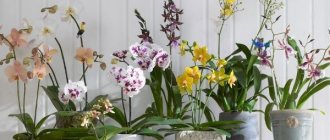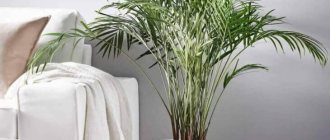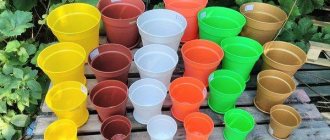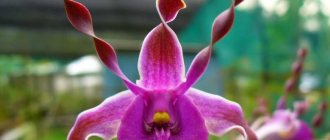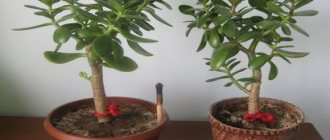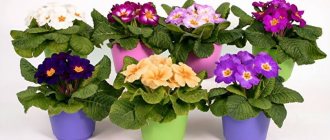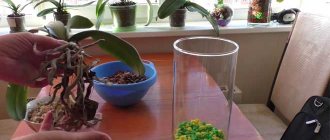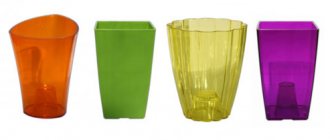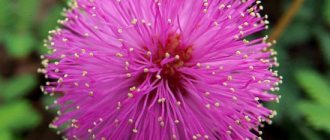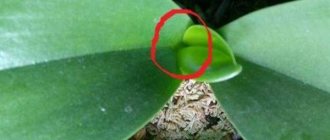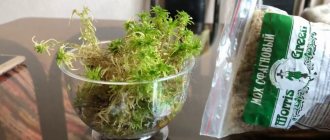Requirements for flower containers that must be met
Orchids belong to the category of plants in which the root system is involved in photosynthesis. Therefore, the penetration of sunlight through the walls of the container is of great importance. The container for epiphytes must be transparent.
The right pot must meet several more requirements:
- Given the natural growth conditions, the plant does not require a large container. It should be slightly larger than the root system.
- The container should provide good aeration of the roots and unimpeded drainage of excess moisture. To do this, there should be several holes at the bottom.
- The plant requires maintaining a certain temperature regime, so it is preferable to use plastic pots.
The right container for an orchid creates favorable conditions for the plant - as close as possible to its natural habitat.
The correct choice of container affects the well-being of the flower in the next few years, so you need to follow some rules.
Correct for common domestic species
Phalaenopsis is the most common type of flower that can be kept at home. This epiphyte will feel comfortable both in standard containers, the height of which is greater than the width, and in bowls with an open root system. The main condition is a large number of drainage holes and transparency.
Read more about which container to choose for phalaenopsis here.
For dendrobiums you need to choose small containers. The volume of the pot should correspond to the volume of the root system.
Cattleyas, on the contrary, need spacious containers with a wide neck - baskets or bowls.
Cymbidium roots grow vertically downwards, so the plant needs tall transparent pots with drainage holes. Otherwise, the development of the root system will be limited to the bottom of the container.
Should it be transparent or not?
A transparent pot is required only for phalaenopsis; the roots of this variety take part in photosynthesis. Other species can grow in containers of any color.
This container will be useful for beginning gardeners. Through the walls you can monitor the condition of the roots and control the need for watering.
Why and what is not suitable?
There are several options for containers, the use of which is strictly contraindicated for orchids of any kind.
It is not recommended to use:
- containers without ventilation holes on the sides and drainage holes at the bottom;
- metal;
- unstable or with a narrow neck.
Which option would be the most “correct” and why?
For most types of orchids, clear plastic pots are fine. They transmit light and are resistant to temperature changes.
In such pots you can monitor the level of soil moisture, and if necessary, you can easily drill additional drainage holes. But you should only choose stable plastic pots so that the plant does not tip over.
Glass pots look aesthetically pleasing and transmit light well, but have low air permeability. That is why it is recommended to grow in them only those types of orchids that do not require additional air supply, for example, Phalaenopsis, Vanda or Ascocenda. In this case, you need to choose containers with a wide base and a narrow top.
Wicker baskets and hanging flowerpots look impressive in any interior . Thanks to the ability to hang them higher, the plants in them will be protected from accidental damage, especially if there are animals or small children in the house. It is better to grow large types of orchids in them, for example, Corianthes, Stanhopea or Dracula.
Choosing a suitable pot is no less important in growing an orchid than the other rules for caring for a flower. A correctly selected container will help create optimal conditions for the plant. The success of its development and flowering depends on how comfortable the orchid is in its house.
Options with photos
The range of products for gardeners offers a large number of different containers for growing. Before purchasing, you need to figure out which option will be most suitable for planting a certain type of plant.
Plastic
The most common and affordable type of pot. The orchid roots do not stick to the walls, sunlight penetrates well into the root system, and thanks to the transparency of the vessel, you can monitor the health of the roots. The unpresentable appearance is the only disadvantage of such a container. Suitable for all types of plants.
Glass vase for closed system
Orchids in a glass vase or flask look especially impressive and will be an excellent gift for any occasion. However, such a container is suitable only for those varieties that allow growth without soil (in or without water). Vandas and phalaenopsis are grown in this way.
It is not recommended to place a flower in a glass vessel on a windowsill or refrigerator to prevent excessive hypothermia.
Read more about how to grow crops without soil in this article.
Crown with holes
The design of such a container is designed specifically to meet the needs of capricious orchids. It consists of a small tray and rods extending from it, through which air circulates. Well suited for phalaenopsis and vandas.
The gaps between the rods are both plus and minus at the same time. The substrate will be washed out through these holes during operation. In addition, the container system will not retain moisture inside; it will quickly evaporate through the walls. You will have to water the flower more often. Also, “Crown” containers are more expensive than regular ones.
Double
Consists of two containers. The internal one is equipped with a large number of drainage holes and a footrest for the accumulation of liquid.
A double pot for orchids includes an automatic watering system. In such containers, it is necessary to constantly ensure that the liquid in the pan does not stagnate, otherwise this will lead to rotting of the roots. Flower growers have fallen in love with the double, inexpensive containers from Fiji.
Clay
Unfired clay retains and distributes moisture well in the root system. The substrate in such a pot dries out and does not rot. The containers have an impressive mass and are stable. The rough surface of the vessel is noted as a disadvantage. The roots will stick to the walls.
Dendrobiums, oncidiums, brassias and cattleyas grow well in clay containers.
Ceramic
An orchid in a ceramic pot looks aesthetically pleasing. The roots breathe well, so they require frequent watering. The inner surface is smooth, so the roots do not grow.
Wooden hanging basket on the wall
Pots made from natural materials are characterized by good air exchange and lightness.
The porous structure of the walls ensures good ventilation of the root system. Moisture evaporates quickly, so the orchid needs to be watered more often. Externally, such baskets look very aesthetically pleasing and are a beneficial addition to the plant. Thanks to the hanging design, it can be placed anywhere. Great for Vandas and Cattleyas.
Large and ideal for several plants
Paired orchids will be a wonderful addition to the interior; as a rule, two different varieties are used. Plants are planted in a single container or in one that has two special compartments.
Preference should be given to containers that are not deep and wide.
Special with automatic watering
The auto-watering function greatly simplifies the procedure for caring for the plant. This option will be especially relevant for flower growers who are often absent from home.
You can purchase a container with automatic watering at any flower shop. But you can design such a container yourself. The most popular option is a pot with a tray.
Bamboo
Bamboo containers are pots made from bamboo rods. Their composition brings the conditions for keeping orchids in the natural environment as close as possible.
The mesh design of the container provides good ventilation, which promotes uniform drying of the substrate.
Bamboo pots, as a rule, are not small in volume and are intended for growing large varieties.
Backlit
In conditions of lack of natural light, you can support the normal development and health of the flower using a backlit pot. Such models will be effective in autumn and winter. This design can be used as a night light. The only negative is the high cost.
An alternative to such a container would be to install artificial lighting. Read how to do this here.
Materials from which growing containers are made
Glass
Glass planters are very beautiful, but they have a number of disadvantages :
- Does not maintain temperature during sudden changes in temperature;
- Container weight;
- Fragility;
- Price;
- A small number of different forms.
Despite the fact that there are certain inconveniences, many gardeners still prefer to grow flowers in glass flowerpots .
Ceramics
Only experienced gardeners can afford to cultivate the plant in ceramic pots . Because you need to determine the time of watering. Typically, gardeners look at the condition of the roots; they will immediately have to water based on their intuition.
When transplanting, very often the velamen of the roots grows to the walls of the pot , and then you have to sacrifice the pot or the root system of the flower when replanting.
Handmade
You can make a container for an orchid with your own hands. The main thing is to adhere to the basic requirements for pots. The material used is plastic or wood.
A plastic container is the simplest and most affordable option. You need to follow a few simple steps:
- take a plastic container as a basis: a bottle, bucket, etc., which can be purchased at a disposable tableware store;
- using a soldering iron or a heated nail, make many drainage holes on the bottom and sides;
- The pot for the plant is ready.
The video shows a manufacturing option:
Pots made from plastic bottles
In debates about which pots are best for orchids, they often use the possibility of installing automatic watering, remembering that an orchid flower in a pot requires a certain soil and air humidity.
To make your own pot with automatic watering, you can use two plastic bottles with a volume of two and one liter. The pot itself and the automatic watering system will be made from them. This is done as follows:
- To make a container for watering, a two-liter bottle is cut to a height of twenty centimeters from the bottom and its lower part is used;
- Eight cuts are made at the top, four centimeters deep, to form stands for the pot;
- The resulting segments are bent inward after one;
- To fill the container with water, the neck is cut off from the remaining upper part of the bottle;
- A hole is marked in the lower part of the manufactured drinker so that a spout can be attached;
- The neck is attached to the cut hole using thermal glue;
- To make a pot, a liter bottle is cut to a height of fifteen centimeters;
- An outer bend of one centimeter is made along the edge of the upper part, into which the stands of the automatic watering tank are then placed, which will hold the pot;
- Eight to ten holes are made at the bottom, through which dense fabric cords are threaded, through which water will flow from the watering container into the pot;
- The cord should be of such length that it can reach the bottom of the drinker;
- The substrate is poured into a pot with threaded cords and the plant is placed;
- The watering container is filled with water and a pot with an orchid is placed on it;
- As necessary, water is added through the spout;
- To supply additional air to the root system, several additional side holes can be made in the pot.
Such a pot with automatic watering allows you to constantly maintain the humidity required by the plant and avoid overwatering, which is detrimental to the orchid’s root system.
As you can see, pots for orchids at home can be very different, both in material, size and shape, and even in function.
Although an orchid in a pot is considered a rather capricious plant when grown indoors, the correct choice of pot for planting and proper care of the orchid in a pot at home will avoid many problems in its further maintenance. Therefore, you should decide in which pots to grow orchids in advance, before you purchase the plant.
We hope that thanks to our material, you now know exactly which pots are best to plant orchids in and which flower pots for orchids to prefer.
Soil: which is better?
They strive to make the composition of soil for orchids as close as possible to the tropical natural conditions of plant growth. The substrate should be light and loose.
The soil can be single-component and consist only of pine bark or multi-component, additionally including expanded clay, moss, coal, expanded clay, peat, coconut fibers, perlite, vermiculite, fern roots and charcoal.
Orchid pot size value
The size of the orchid pot is also important. There is no need to buy a pot that is too large for your orchid.
It is desirable that their diameter is equal to their height. Large pots for orchids mean that the soil in them will dry out unevenly, which can cause rotting of the roots.
In turn, very small pots without proper support often turn over, which leads to injury to the plant. How to choose the right size pot for an orchid? So that the root system is a little cramped.
Orchid substrate components
photo from the site harbuz.info
The substrate can be selected for each specific plant, based on its needs and the climate in which it will grow. The soil can consist of either one pine bark or several components. The most commonly used are bark, sphagnum moss, high-moor peat and fern roots.
Bark
Pine bark is the main substrate component for many types of orchids. You can either purchase it in a store or prepare it yourself; you just need to follow a few rules. You can collect bark from the ground, but remove it only from fallen trees. Fresh bark is unsuitable due to its resinous content, and removing it from the trunk of a living tree can harm it.
The bark should be free of signs of disease or pests. Before use, it must be boiled to remove residual resin and get rid of pathogens.
Pine bark substrates also need to adjust their acidity, so dolomite flour is added to them (1-3 g per 1 liter of soil).
Instead of pine, you can use the bark of other coniferous trees: fir, spruce, thuja, juniper, as well as deciduous trees: oak, willow, etc.
Store collected material in large pieces and chop only before use.
Moss
Sphagnum moss is usually added to substrates, which is highly hygroscopic and more nutritious for plants than bark. It also acts as a sorbent that absorbs salts harmful to plants. Moss stores well both dry and frozen.
It is better to collect it in late autumn, after the first frost, when the number of pests in it decreases. Harvest only its top green part. Store in plastic bags on the balcony, basement or freezer.
To remove pests from moss, soak it in water and then dry it until it turns light brown.
Peat
To prepare the substrate, it is best to use sphagnum high-moor peat, which has high moisture capacity and absorbs and retains nutrients well. Another useful property: when completely saturated with water, it can hold up to 40% of air.
The downside is its acidity. Therefore, a week before preparing the substrate, neutralize it with dolomite flour (7-10 g per 1 kg of peat).
The pH level of store-bought peat should be 5-6.5.
Fern roots
photo from thespruce.com
For many years, the roots of the osmunda fern were considered the best substrate for orchids. You can also use other species that grow in our forests. You can set up their plantation on your own property.
In the forest, ferns can be harvested in clearings, clearings and in places intended for inclusion in economic circulation. Wash the dug roots from the ground and dry. Both thin roots and thick rhizomes are suitable for the substrate, which must be cut with pruning shears into pieces several centimeters thick.
This substrate practically does not caking and retains its properties for a number of years.
Charcoal
photo from spinifexcountry.com.au
Many substances useful for orchid nutrition - potassium, calcium, phosphorus and trace elements - are contained in charcoal. It is used to neutralize the acidic environment from the bark of coniferous trees and to absorb excess water from the substrate.
For the substrate, pieces of charcoal at least 3 cm in size are best suited.
In addition to these materials, expanded clay, perlite and other leavening agents, coconut fiber and coconut chips are also used in substrates.
